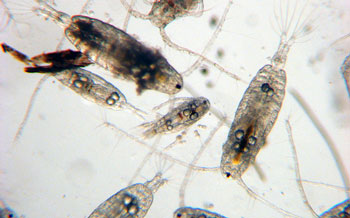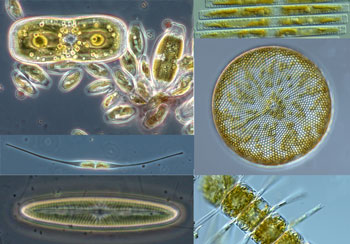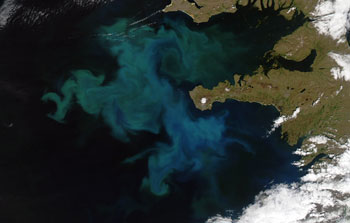What are plankton?
 Plankton are aquatic drifting organisms which means they are incapable of swimming against the current and instead, "go with the flow." The term, plankton, doesn't define the organism but how the organism lives. Plankton may be plant-like organisms, called phytoplankton or animal-like organisms, called zooplankton. In this way we classify the organisms based on lifestyle, not taxonomy. Other examples include nektonic organisms, which have the ability to swim freely and can swim against the current, and benthic organisms, which live on the bottom of sea floors and are often fixed in place. Plankton come in many different shapes and sizes. They can be as small as bacteria or a large as jellyfish.
Plankton are aquatic drifting organisms which means they are incapable of swimming against the current and instead, "go with the flow." The term, plankton, doesn't define the organism but how the organism lives. Plankton may be plant-like organisms, called phytoplankton or animal-like organisms, called zooplankton. In this way we classify the organisms based on lifestyle, not taxonomy. Other examples include nektonic organisms, which have the ability to swim freely and can swim against the current, and benthic organisms, which live on the bottom of sea floors and are often fixed in place. Plankton come in many different shapes and sizes. They can be as small as bacteria or a large as jellyfish.
Why are plankton important?
 Plankton can be producers, consumers or both. They play important roles in aquatic food webs and are a source of food for larger aquatic organisms. Phytoplankton, also called algae, are producers that photosynthesize, meaning they convert energy from the sun, carbon dioxide, and other nutrients in the water into food for themselves. They contribute up to 50% of the world's oxygen to the atmosphere. Some examples of phytoplankton are diatoms and dinoflagellates, which are responsible for seasonal algae blooms. Zooplankton are consumers that eat other plankton. Examples include copepods, krill, daphnia and jelleyfish. They are an important link between primary producers and higher trophic levels. Baterioplankton are single-celled, free-floating organisms. They are the decomposers and nutrient recyclers in an aquatic system.
Plankton can be producers, consumers or both. They play important roles in aquatic food webs and are a source of food for larger aquatic organisms. Phytoplankton, also called algae, are producers that photosynthesize, meaning they convert energy from the sun, carbon dioxide, and other nutrients in the water into food for themselves. They contribute up to 50% of the world's oxygen to the atmosphere. Some examples of phytoplankton are diatoms and dinoflagellates, which are responsible for seasonal algae blooms. Zooplankton are consumers that eat other plankton. Examples include copepods, krill, daphnia and jelleyfish. They are an important link between primary producers and higher trophic levels. Baterioplankton are single-celled, free-floating organisms. They are the decomposers and nutrient recyclers in an aquatic system.
What causes a plankton bloom?
 Generally, phytoplankton populations are kept in check because their growth is limited by some factor, such as light or nutrients. However, when one or more of the factors that limit phytoplankton growth becomes abundant, a plankton bloom, characterized by a sharp increase in the plankton population, may occur. Phytoplankton blooms (also known as algal blooms) naturally occur in the spring as daylight increases, temperatures rise, and nutrients from land are brought into a body of water from runoff, all which feed the algae. Blooms often consist of one species of phytoplankton that reproduce quickly. Large blooms can even change the color of the water to green, yellow-brown, or red.
Generally, phytoplankton populations are kept in check because their growth is limited by some factor, such as light or nutrients. However, when one or more of the factors that limit phytoplankton growth becomes abundant, a plankton bloom, characterized by a sharp increase in the plankton population, may occur. Phytoplankton blooms (also known as algal blooms) naturally occur in the spring as daylight increases, temperatures rise, and nutrients from land are brought into a body of water from runoff, all which feed the algae. Blooms often consist of one species of phytoplankton that reproduce quickly. Large blooms can even change the color of the water to green, yellow-brown, or red.



